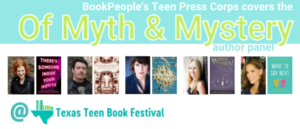It’s All in the Twist: Of Myth & Mystery, Secrets & Truth
by Haley Justiz, BookPeople Teen Press Corps
Of Myth and Mystery was such a fun panel! It featured E. Lockhart, Cory Putman Oakes, Julie Buxbaum, Stephanie Perkins, and David Bowles. These authors tackled dozens of questions about the complexities behind their characters and the writing experience as a whole.
First, Julie Buxbaum challenged one of the most common plot holes in YA: the absence of parents from plot. She explained that “Your parents are all about figuring out who you are. It’s so important to show that inherent tension that is between you and your parents in trying to figure out who you are and who you are without them.” Cory Putman Oakes agreed, expounding on the important role that parents play in shaping the kinds of people teens become.
As a writer, Buxbaum has to ride the line of understanding her adults as fully fleshed individuals who make mistakes, and then feed that through the eyes of her much younger characters. Both Oakes and Buxbaum agreed that they definitely relate more to their teen characters than to the parents.
In response to how to craft a realistic character, David Bowles said that “You have to think about where characters come from, what shaped them, and how to represent it.” The decisions characters make as they’re drawn into different adventures are all predicted by the way that they’ve been raised and how that’s formed their character. In the case of Bowles’ novel, Mexican-American parents are always involved in everything their kids do, so it’s important to portray that. As for the mythological aspects of his story, research is essential to look into the origin of the world.
Lockhart agreed with the importance of characters’ stories, noting the significance of the Hulk’s past in shaping who he is in the comics. “My main character is the female version of Hulk,” Lockhart said, earning some laughs from the crowd.
Moderator Kayla Olson posed a question that most readers have wondered at one point or another: how do books help us to relive the best parts of life, deal with the worst, and help us to live our lives? Olson’s friend once told her that he doesn’t read fiction because he doesn’t want to read anything that isn’t true. Olson countered that “These things in fiction are true, to human experience.”
Buxbaum wholeheartedly agreed, noting that writing fiction is the way in which she processes the world. She explained, “It shows in my writing. I don’t even realize it until years later when I see it reflected in my work. Fiction is my way of looking at a problem sideways and working through it, and I hope I give it to the reader, too. It’s not a direct solution. It’s built into the DNA of a book.”
Stephanie Perkins echoed what Buxbaum said, adding that shame was the key emotion she ended up grappling with time and time again. As she explored what makes something scary for her latest release, she had to start grappling with it in real life. Perkins admitted, “It isn’t a basic movie fear or jump-scare. It’s the fear of shame which I feel is the worst fear humans can have. So my main character is dealing with something very shameful.”
Of Myth and Mystery was a fantastic panel that gave readers a special insight into the fascinating and complex world of writing. Be sure to check out the authors’ interviews (here on this blog) and their incredible books!
